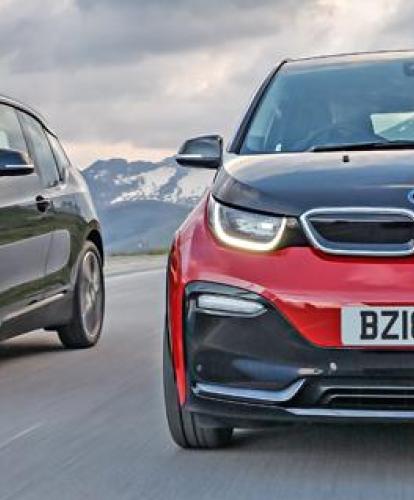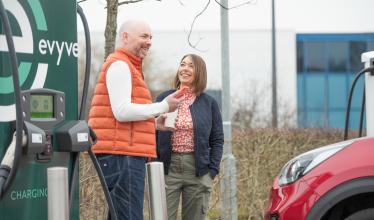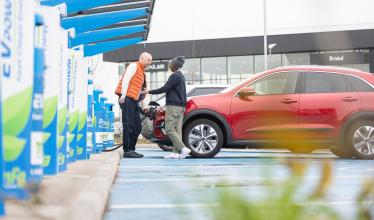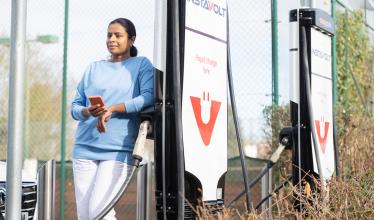Electric vehicles are made up of two main types: battery-electric vehicles (BEV) and plug-in hybrid electric vehicles (PHEV).
Battery-electric vehicles
BEVs have no combustion engine, only an on-board battery which provides energy to an electric motor. Pure EVs are charged from an external electricity supply, typically plugging in to an EV charge point. When required, energy is drawn from the electric cells and converted to motive power by the use of one or more electric motors.
Plug-in hybrid electric vehicles
PHEVs have an electric powertrain together with a small- to medium-sized combustion engine, which enables operation in full electric mode, using conventional fuel, or a combination of both. Like standard hybrids, the use of a battery enables the combustion engine to be operated at high efficiency. Unlike their conventional counterparts, PHEVs also have an ‘inlet’ socket allowing them to be charged directly from an external electricity supply.
Rechargeable batteries are used in both types of EV, the most common types being lithium-ion (Li-Ion) or lithium-polymer (Li-Poly). An on-board battery also enables the use of regenerative braking, which tops up the battery during braking, reducing overall energy use by around 20%. In this way, all plug-in electric cars provide high energy efficiency and/or fuel economy and are classed for tax purposes as zero- or ultra-low emission vehicles (ULEVs).
Types of electric cars

BEVs
With an ever increasing number of electric models to choose from, the majority of BEVs available to buy new have a real-world driving range of 200-250 miles on a single charge, depending on the model. As a result, electric cars are well suited for use as private cars and in vehicle fleets, although it is wise to plan ahead for longer journeys, either ensuring that a suitable charging location is available or adjusting routes and time to accommodate a stop to charge the battery and grab a coffee en-route.
Pure-electric cars also offer a number of key benefits, such as being able to charge at home or charge at work overnight when electricity is cheap which reduces overall fuel costs by more than 70%.
Explore our live map of charging points
PHEVs
While PHEVs offer longer range overall, as well as greater fuel flexibility because they can be charged directly using any suitable source of electricity or can be refuelled using petrol or diesel, they are increasingly seen as a ‘transition’ technology in the shift to fully electric vehicles.
However, with smaller battery backs, PHEVs are unable to match pure-EVs for electric driving range. They are also often heavier and more complex as two powertrain technologies have to be accommodated. Grants and tax breaks tend to be lower for plug-in hybrids, a reflection that they cover fewer miles in zero-emission mode.
Furthermore, while PHEVs can use slow and fast public charging points, most are unable to utilise the growing network of rapid and ultra-rapid chargers, meaning that longer journeys are generally driven using the conventional engine.
Capable of being used as a zero-emission vehicle, PHEVs were initially very popular – offering the best of both the conventional and electric driving experience – but are now declining in popularity with most buyers opting for their fully electric cousins.
Electric car driving experience: BEV vs PHEV

Most electric vehicles have excellent acceleration and high torque, especially at lower speeds, and are more than capable of holding their own on the road. Electric cars can also be high performance vehicles, with acceleration times from the likes of the Tesla Model S Performance as fast as, or quicker than, even the most powerful hypercars on the market.
BEVs
In many respects, plug-in electric cars offer a very different driving experience to using a conventional car. On pressing the accelerator, an EV initially moves in almost total silence, which can be a little disconcerting at first – though for safety purposes pure-electric cars are fitted with noise generators for low speeds. As the speed picks up, the small amount of ‘engine’ noise that can be heard is quickly masked by wind and tyre noise, which become more noticeable as the speed increases.
PHEVs
The driving performance of plug-in hybrids is very similar to a pure EV or a conventional hybrid, depending on which vehicle ‘mode’ is selected. PHEVs typically offer at least two driving modes: ‘zero-emission’ which forces the vehicle to run on electricity (if charge is available) and ‘eco’ during which the car decides how to most efficiently use conventional and/or electric power. As PHEVs can accept two fuels, they can either be charged directly, or refuelled with petrol or diesel in exactly the same way as conventional vehicles.



